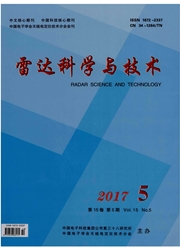

 中文摘要:
中文摘要:
在短相干积累时间(CIT)情况下,天波超视距雷达(0THR)中低速目标检测很困难:低速目标靠近强大的海杂波频谱;短CIT导致多普勒分辨率低,使目标信号与海杂波更难区分。传统方法一般利用海杂波与目标信号的时频特征不同来抑制海杂波,目标速度较高时这些方法很有效,然而在短CIT、低速目标情况下目标与海杂波信号的时频特征的区分度很小,使得传统方法难以有效抑制海杂波。针对上述问题,考虑到海杂波与目标信号具有不同的动力学特征,提出一种基于回声状态网络的天波雷达海杂波抑制方法。该方法首先用海杂波参考信号训练回声状态网络,使该神经网络“记住”海杂波的混沌动态特征;然后用前述训练好的网络重构和预测天波雷达回波中的海杂波,雷达回波减去该重构的海杂波,实现海杂波的抑制。实测数据处理结果证明了与传统的循环对消法以及sVD方法相比,该方法具有更好的海杂波抑制性能。
 英文摘要:
英文摘要:
In the case of short coherent integration time(CIT), it is difficult for over-the-horizon radar (OTHR) to detect low speed targets:low speed targets are close to the strong sea clutter spectrum; short CIT leads to low Doppler resolution and make it harder to distinguish the target signal from sea clutter. Tra- ditional methods generally use the different time-frequency characteristics between sea clutter and target sig- nal to suppress sea clutter, it is very effective for high speed target. However, in short CIT and low speed situation, the time-frequency characteristics of target and sea clutter signal have small discrimination; tradi- tional methods cannot effectively suppress sea clutter. In response to these issues, taking into account the sea clutter and target signals with different dynamic characteristics, this paper presents an OTHR sea clutter suppression method based on echo state network. Firstly, the sea clutter reference signal is used to train echo state network, so that the neural network can "remember" the chaotic dynamic characteristic of sea clutter. Then the trained network is used to reconstruct and predict OTHR sea clutter. Subtracting the reconstructed sea clutter from the radar echo can achieve sea clutter suppression. The processing results of the measured data show that the proposed method has better sea clutter suppression performance than the traditional cycle cancellation method and SVD method.
 同期刊论文项目
同期刊论文项目
 同项目期刊论文
同项目期刊论文
 期刊信息
期刊信息
